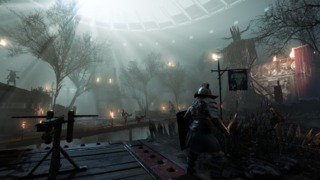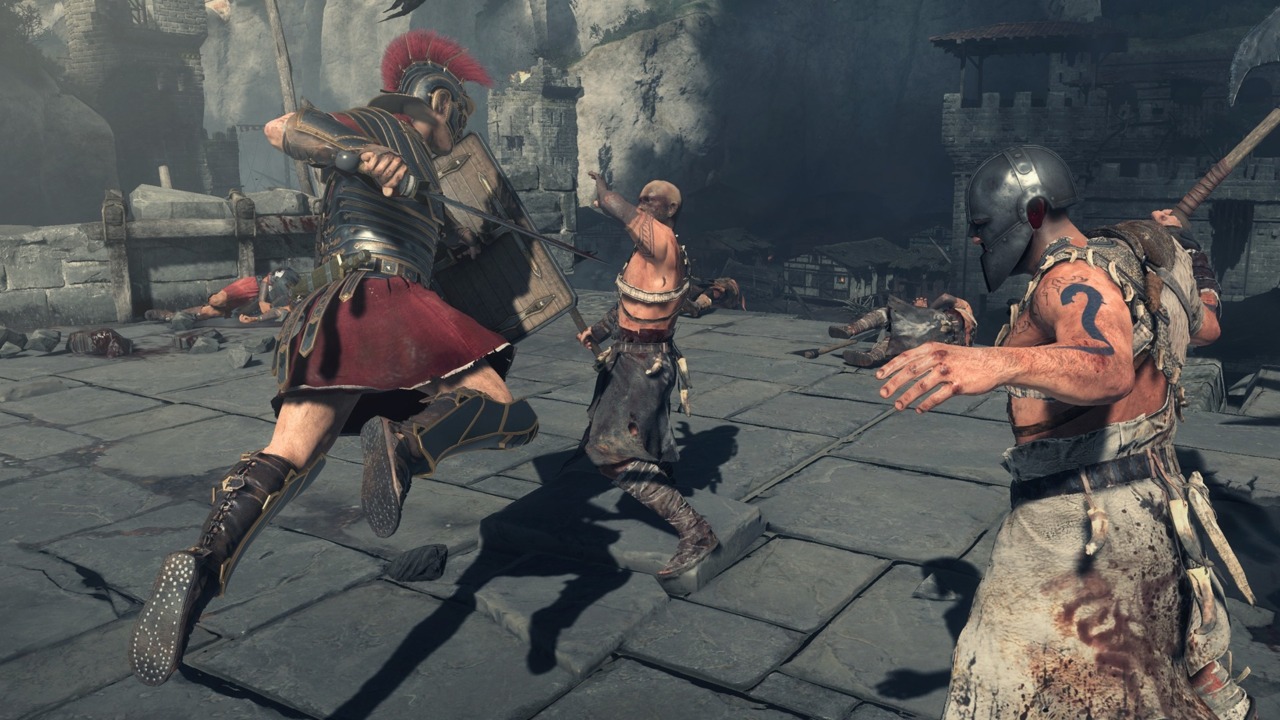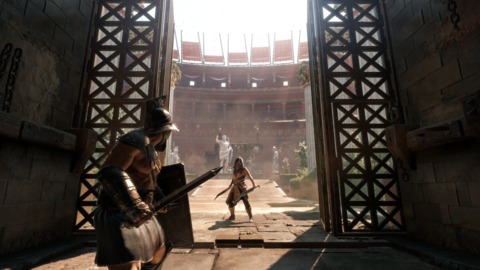If our pop culture view is any indication, ancient Rome was a violent and troubled empire, characterized by beheadings and gladiatorial bloodthirst. The trailers and demos for Ryse: Son of Rome do little to discredit our mental images of Roman ferocity; it would be impossible to calculate how many gallons of blood are spilled within them.
Struck by these displays of murder and brutality, I recently spoke with Crytek's director of cinematics, Peter Gornstein, and animation director Martin L'Heureux. I asked them about the brashness and the bloodshed on display. Is Ryse's primary dictate to be loud and gory?
Apparently not, according to Gornstein. He acknowledges that Ryse is violent, in part because it takes place in an incredibly violent time period. But the game isn't about brutality--it's about drama.
Fallout 4 Next Gen Update Comparison Fallout 4 Steam Deck Verified Gameplay ALIEN: Rogue Incursion - Announcement Teaser Trailer Stellar Blade - 13 Things I Wish I Knew S.T.A.L.K.E.R. 2: Heart of Chornobyl — Official "Not a Paradise" Trailer Sea of Thieves Season 12: Official Content Update Video Why Are Video Game Adaptations Good Now? | Spot On Manor Lords - Official Medieval City Builder/RTS Launch Trailer Honkai: Star Rail - "Then Wake to Weep" | Version 2.2 Trailer Devil May Cry: Peak Of Combat | Dante: Blazing Tempest Gameplay Trailer SAND LAND — Official Launch Trailer Stellar Blade - Hard Mode No Damage Gigas Boss Gameplay
Please enter your date of birth to view this video
By clicking 'enter', you agree to GameSpot's
Terms of Use and Privacy Policy
"I don't think we want to create spectacle of violence," Gornstein explains. "I think more we want to create cinematic spectacle, and you know, amazing sort of visuals. Of course, our game has action and that's not entirely coincidental, and we're trying to be visually wowing, but it's certainly not our intention to dwell on violence for the sake of violence."
"We try to push in every direction," L'Heureux adds. "When you look at some Roman movies, you see some violence, and some of them are actually extremely violent. But the thing you remember at the end of the movie is story, right? Of course the violence is there as a vehicle for the story, as well, we try to push and maximize on that, but it's not really all about that."
I can't imagine playing a game that maintains these kind of visual histrionics for long period of time, however. Bloody or not, sensory overload can make the acrobatic animations and colossal explosions seem boring and commonplace when they're erupting in our faces time and time again. Based on Ryse's previous showings, I was convinced that the upcoming Xbox One exclusive was about chest-pounding victory and viscera-strewn battlefields. Crytek, however, wants us to know that Ryse is more subtle than they may have first let on.
Fallout 4 Next Gen Update Comparison Fallout 4 Steam Deck Verified Gameplay ALIEN: Rogue Incursion - Announcement Teaser Trailer Stellar Blade - 13 Things I Wish I Knew S.T.A.L.K.E.R. 2: Heart of Chornobyl — Official "Not a Paradise" Trailer Sea of Thieves Season 12: Official Content Update Video Why Are Video Game Adaptations Good Now? | Spot On Manor Lords - Official Medieval City Builder/RTS Launch Trailer Honkai: Star Rail - "Then Wake to Weep" | Version 2.2 Trailer Devil May Cry: Peak Of Combat | Dante: Blazing Tempest Gameplay Trailer SAND LAND — Official Launch Trailer Stellar Blade - Hard Mode No Damage Gigas Boss Gameplay
Please enter your date of birth to view this video
By clicking 'enter', you agree to GameSpot's
Terms of Use and Privacy Policy
Gornstein, for his part, understands that grand spectacle isn't effective when it isn't balanced by quiet moments. "That's why for the journey that Marius Titus goes on," Gornstein says, "what we've put together is a full animated feature film that's sort of interwoven with the story. We get to know Marius as a full three-dimensional character. We see him struggle with emotions, we see him, you know, sacrifice for his comrades, all that is interwoven. And we have… I wouldn't say long, but we have substantial scenes that build the characters, not just Marius, but main story characters. And through that stuff together is interwoven a full feature film. So these character-building moments are in there to ensure that the pacing feels right. That you're not just… a ten-hour orgy of combat. We want to get that balance of combat, story, character, and moments."
The answer gives me pause--and Gornstein is quick to pick up on my misgivings. Does Ryse just want to be a film? What is Crytek doing with Ryse that allows it to tell this story in a way only a game could tell it?
We think it's really important for the audience to empathize with the character, to give the character a real personality.

"Well the difference is that you get to play the main character, right?" says Gornstein. "It's in making a visceral experience. We think it's really important for the audience to empathize with the character, to give the character a real personality. Make him a human being to kind of identify with. We spent hours working with Martin on the animations, we try to make as fluid an experience as we could going from the gameplay to the cinematics. The visual fidelity in the cinematics and the gameplay is completely identical. You have facial expressions throughout the whole game, right? It's not like we have, 'oh, now we have a new game character that doesn't react, doesn't have emotions, and then we cut to the cinematic and it's a whole different level of fidelity.' We have it consistent through the whole game."
L'Heureux adds, "It's also that everyone around Marius, if you're looking at the way characters are reacting, as Marius is engaging in combat, the fidelity, the level of complexity you get in facial expressions on the enemies around Marius is the same as you would get in cinematics. So that bridge is… we're crossing that bridge very close."

Gornstein concurs. "We really try to make it like an interactive movie where you basically sit down and you… I mean, it's a game, obviously, but we want the story moments to feel seamless as you get into them. And then we have some really really talented actors, I think when you see the final work, we're really proud of the way it looks and plays."
So who is this Marius Titus? In trailers, we've seen him roaring in victory in a gladiatorial arena, bashing in barbarian skulls with his shield, and crushing heads underneath the heels of his massive boots. Obviously, a trailer isn't going to tell us all we must know about a story or its protagonist, but I don't know who this man is, or what makes him different than the other helmeted heroes we've met over the years in our games, films, and literature.
Gornstein tells me that Marius begins this tale as "a regular guy like you or me." And from there grows Ryse's story of revenge. "He starts off as a basic recruit in the army. And as he returns to greet his family in Rome, you know, he finds them slaughtered by barbarian bandits. And that kind of sets him out on the journey where he goes to the furthest regions of the empire to wreak his vengeance. Of course there are twists along the way that you discover. What's mainly interesting is that Marius is portrayed as a real character and he takes a beating, right? He's not a super hero. We want to make it feel like when you get hit, you feel the pain of the hit. It's not just, you know, a Rambo-type scenario. He's definitely more of a real human being with emotions that, you know, when I take a beating, I can feel it."
So you can smash their heads against the wall and what it is, it shows the character is able to improvise.
And so we return again to the language of violence, a language Ryse is fluent in. Just a few moments ago, Gornstein has told me that Crytek does not want to dwell on violence for violence's sake, yet here is a main character defined by vengeance, and by how much pain he can endure. I'm still not sure who this man is--I only know what purpose he serves in the plot. Gornstein reassures me that Ryse's cast of characters will be developed beyond their surface attributes. Gornstein says, "It's about having three-dimensional characters, not just Marius but the surrounding cast. So we make sure every story character has a personality that makes them seem more than flat 2D characters. We really put a lot of effort into just visually giving them [personality], but also the way we [motion-captured] them with voice, and with face, and you know, we did one-to-one with the actors. And you know, their personality, what they bring to the stage, I guess you could say, I think it really shines through. And putting that on top of having an interesting story with a main character who has real three-dimensional problems that he's struggling with and combining that with a surrounding supporting cast, that also is more than just black and white. I think that mix creates an interesting ensemble that tells a story that goes beyond, you know, a two-dimensional, usual hero's journey."
In spite of Gornstein's promises of a well-developed hero, I remain skeptical. The story always wraps back onto Marius' bloodthirst; I still have no sense of who this man actually is. So I ask L'Heureux how the gameplay could be used to further develop Marius Titus and the world that surrounds him.

"Well that's very simple," says L'Heureux, and my ears perk up. "As you're playing, right, you can be in the middle of an arena, you're fighting, and obviously the type of stuff you can do in the middle is affected by what you have around you." And the violence--the thing that Ryse isn't all about--becomes what it's all about anyway. My excitement wanes, and L'Heureux continues. "That's when you're standing, when you're fighting, when you're doing executions. But if you end up pushing the character, for example, against a corner, or a crop, or anything, and the way you finish your opponent changes. And actually you feel like you're part of the environment."
And so my search for the third dimension in Crytek's Roman epic may be a lost cause. At the very least, it's clear I need to be ready to speak Ryse's language, and so I give myself over to it. Ryse: Son of Rome is likely to be an epic spectacle of blood-coated iron, and that's OK.
Gornstein's addition to the conversation affirms that it's best to let go of any pretension. "The environment comes as a set of tools that you can vary the way you attack and execute your opponents," he says. "So you can smash their heads against the wall and what it is, it shows the character is able to improvise, use the environment around him to fight."

And so now we can all be at ease. When the chat focuses on fighting, the game takes clear shape. Elaborating on the combat, L'Heureux says, "When we started looking at Roman fighting, the first thing we did is study what the Romans were doing back then. And you start realizing quickly that the Romans fight in a very defensive way, which is not very heroic. So we start looking more into mixing different fighting styles. And at the end we realized that the more we were borrowing from different styles, the more rich the fighting was becoming. So for instance, we all know that with those crazy armors and swords, you don't just start jumping up in the air and doing a crazy flip, but we said at the beginning, 'oh no, we can't do this, we want to do something real, it has to be a true experience.' And at the end we realized, actually, it's still good to see Marius jumping in the air, and smashing his shield down at the barbarians, you see? So we starting exploring more ways of moving. We started to make things more flexible and we started borrowing movement from more fighting styles and made it more rich in the fighting."
It's when L'Heureux starts talking about the executions that Ryse's aspirations become most clear. "So say you have a guy in front of you… two, three, or four in front of you, and one guy coming, charging at you from the left back corner. And you can attack forward, going back, and you can do that seamlessly. And we created a quadrant system that allows the player to just actually target his opponent, and being able to keep that flow and that pressure as you're fighting. And of course, all that to bring down your enemies to a state where they're in a state of, pretty much, of being dead. Which leads to an extra level, where at that point you get into the execution."
The execution is the big thing.
"The execution is the big thing," L'Heureux says, "because a lot of people thought OK, an execution is just an execution. But actually within the execution itself, it goes actually deeper where you have a timing press that will actually give you rewards. So that as you're fighting, even during the execution, you still need to keep on going."
Indeed, the execution is the big thing, given a hero whose primary characteristic is that he can take a beating. I want to believe he really is a regular person, like you or me. But it seems that Marius Titus' softer side has a sharp, bloodied edge.

